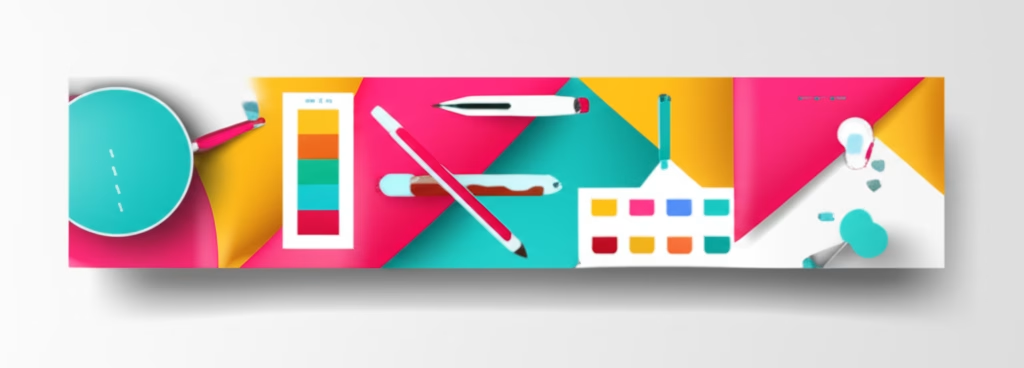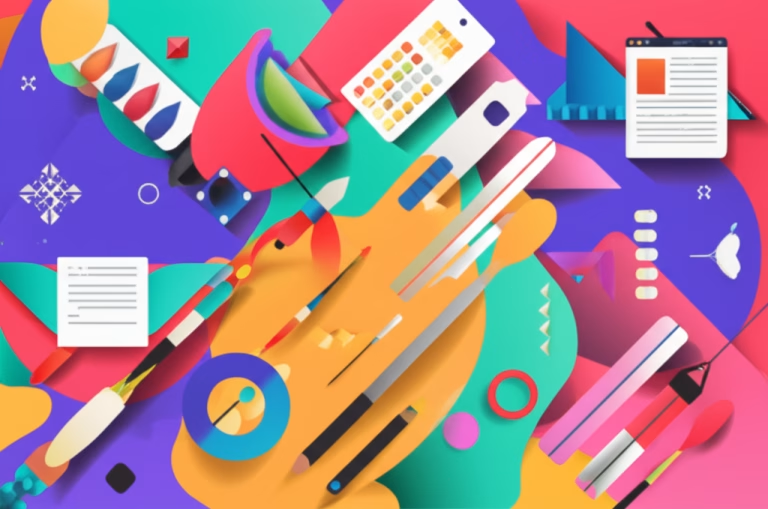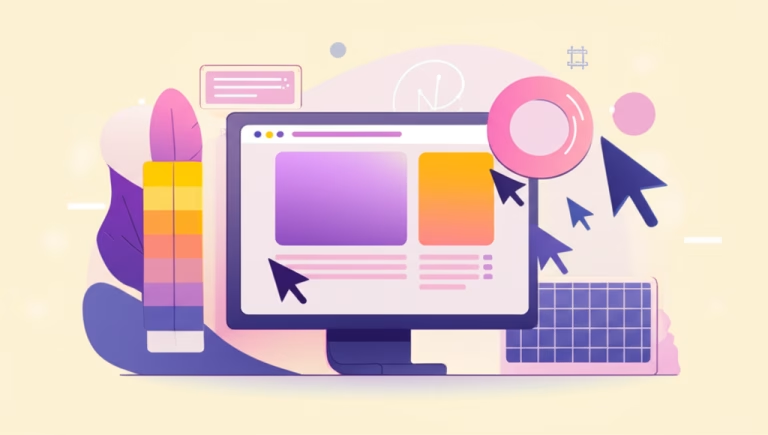Graphic Design for Beginners: A Comprehensive Introduction
Ever looked at a stunning poster, a sleek website, or a captivating logo and wondered how it was created? That’s the magic of graphic design! It’s more than just making things look pretty; it’s about communicating effectively through visuals. This guide will gently introduce you to the world of graphic design, making it accessible and fun, even if you’re a complete beginner. We’ll explore key concepts and practical tips to get you started on your design journey.
What is Color Theory?
Color theory is the foundation of visual communication. It’s the science and art of using color effectively in design. Understanding color theory helps you create visually appealing and impactful designs. It’s not just about picking your favorite shades; it’s about understanding how colors interact and evoke specific emotions.
Understanding the Color Wheel
The color wheel is your best friend. It’s a visual representation of colors arranged according to their chromatic relationship. It typically includes primary, secondary, and tertiary colors. Primary colors (red, yellow, blue) are the base from which all other colors are derived. Secondary colors (green, orange, purple) are created by mixing two primary colors. Tertiary colors are created by mixing a primary and a secondary color.
Color Harmonies
Color harmonies are pleasing combinations of colors. Some common harmonies include: Complementary (colors opposite each other on the wheel), Analogous (colors next to each other), Triadic (three colors evenly spaced), and Monochromatic (variations of a single color). Using these harmonies can help you achieve balance and visual interest in your designs.
Color Psychology
Colors evoke emotions and associations. Red often signifies passion or danger, blue can represent calmness or trust, and yellow is associated with happiness or energy. Understanding color psychology allows you to strategically use colors to convey the right message and connect with your audience. Consider the cultural context as well, as color associations can vary across different cultures. Color choices can significantly impact the effectiveness of your graphic design.
Why is it Important in Design?
Color is a powerful tool. It grabs attention, communicates messages, and creates a mood. Mastering color theory is essential for creating effective and impactful designs. It’s not just about aesthetics; it’s about strategic communication. Without a solid understanding of color, your designs might miss the mark.
Enhancing Visual Appeal
Well-chosen colors can make a design visually appealing and engaging. They draw the viewer’s eye and create a positive first impression. A harmonious color palette can elevate a simple design, making it more memorable and effective. The use of color is crucial in creating a visually appealing user experience.
Communicating Brand Identity
Colors are integral to brand identity. They help create a consistent and recognizable look and feel. Think of Coca-Cola’s red or Tiffany & Co.’s blue. These colors are instantly recognizable and associated with the brand. Choosing the right colors is vital for building a strong brand identity and conveying brand values. Graphic design relies on color to reinforce brand recognition.
Improving User Experience
Color can improve user experience by guiding users through a website or app, highlighting important information, and creating a sense of hierarchy. For example, using a contrasting color for a call-to-action button makes it stand out and encourages clicks. Thoughtful color choices can make a website more user-friendly and intuitive. Effective graphic design prioritizes user experience through strategic color use.
Basic Principles
Beyond color, several other principles guide effective graphic design. These principles help you create balanced, visually appealing, and communicative designs. Understanding and applying these principles is key to becoming a successful graphic designer.
Balance
Balance refers to the visual distribution of elements in a design. It can be symmetrical (elements are mirrored on either side) or asymmetrical (elements are different but still create a sense of equilibrium). Balance creates stability and harmony in a design. A well-balanced design feels visually pleasing and easy to understand. Graphic design uses balance to create visual harmony.
Contrast
Contrast is the difference between elements in a design. It can be achieved through color, size, shape, or texture. Contrast creates visual interest and helps to highlight important information. For example, using a bold font for a heading and a lighter font for the body text creates contrast and makes the heading stand out. Effective graphic design uses contrast to draw attention to key elements.
Hierarchy
Hierarchy refers to the arrangement of elements in a design to indicate their importance. It guides the viewer’s eye and helps them understand the information in the intended order. Hierarchy can be achieved through size, color, placement, and typography. A clear hierarchy makes a design easy to navigate and understand. Graphic design uses hierarchy to guide the viewer’s eye.
Typography
Typography is the art of arranging type. It includes selecting fonts, adjusting letter spacing, and creating a visual hierarchy with text. Good typography makes text readable and visually appealing. Choose fonts that are appropriate for the message and the audience. Experiment with different font sizes and styles to create contrast and hierarchy. Graphic design relies heavily on effective typography.
Alignment
Alignment refers to the arrangement of elements in a straight line. It creates a sense of order and organization. Common types of alignment include left, right, center, and justified. Consistent alignment makes a design look clean and professional. Avoid randomly placing elements; always align them to create a cohesive look. Graphic design uses alignment to create a sense of order.
White Space
White space (also known as negative space) is the empty space around elements in a design. It helps to create balance, improve readability, and draw attention to key elements. Don’t be afraid to leave empty space; it can be just as important as the elements you include. White space gives the eye a place to rest and prevents the design from feeling cluttered. Graphic design uses white space to improve readability and create visual breathing room.
Common Mistakes
Even experienced designers make mistakes. Being aware of common pitfalls can help you avoid them and improve your designs. Learning from mistakes is a crucial part of the design process.
Overcrowding the Design
One of the most common mistakes is trying to cram too much information into a single design. This can make the design look cluttered and confusing. Remember to use white space effectively and prioritize the most important information. Less is often more in graphic design. A clean and simple design is usually more effective than a cluttered one.
Poor Typography Choices
Choosing the wrong fonts can ruin a design. Avoid using too many different fonts (stick to two or three at most) and make sure the fonts are readable and appropriate for the message. Pay attention to kerning (the space between letters) and leading (the space between lines) to improve readability. Typography is a crucial element of graphic design, so take the time to get it right.
Ignoring Color Theory
Using colors haphazardly can lead to a visually jarring and ineffective design. Learn the basics of color theory and use color harmonies to create a pleasing and balanced palette. Consider the emotions and associations that different colors evoke. Color is a powerful tool, but it needs to be used thoughtfully. A strong understanding of color theory is essential for effective graphic design.
Inconsistent Branding
If you’re designing for a brand, it’s important to maintain consistency with the brand’s visual identity. Use the brand’s colors, fonts, and logo consistently across all designs. This helps to build brand recognition and create a cohesive look and feel. Inconsistent branding can confuse customers and weaken the brand’s message. Graphic design plays a vital role in maintaining brand consistency.
Ignoring the Target Audience
It’s important to consider your target audience when designing. What are their preferences, values, and expectations? A design that appeals to one audience may not appeal to another. Tailor your design to the specific audience you’re trying to reach. Understanding your target audience is key to creating effective graphic design.
Step-by-Step: How to Apply It
Now that you understand the basic principles, let’s look at a step-by-step approach to applying them in your design projects. This practical guide will help you translate theory into practice.
1. Define Your Goals
Before you start designing, clearly define your goals. What message are you trying to communicate? Who is your target audience? What do you want them to do after seeing your design? Having clear goals will help you make informed design decisions. Defining clear goals is the first step in effective graphic design.
2. Research and Inspiration
Gather inspiration from other designs. Look at websites, posters, logos, and other visual materials that you find appealing. Analyze what makes them effective. However, don’t just copy other people’s work; use it as a starting point for your own creative ideas. Research and inspiration are crucial for generating creative ideas in graphic design.
3. Sketch and Wireframe
Before you start working on the computer, sketch out your ideas on paper. This will help you explore different layouts and compositions quickly. For website design, create wireframes to plan the structure and content of each page. Sketching and wireframing are essential for planning and organizing your designs.
4. Choose Your Colors and Fonts
Select a color palette and fonts that are appropriate for your message and your target audience. Use color harmonies to create a balanced and visually appealing palette. Choose fonts that are readable and that complement each other. Color and typography are key elements of graphic design, so choose them carefully.
5. Create Your Design
Now it’s time to bring your ideas to life on the computer. Use design software like Adobe Photoshop, Illustrator, or Canva to create your design. Pay attention to balance, contrast, hierarchy, and alignment. Use white space effectively to improve readability and create visual breathing room. Creating your design is where you bring your vision to life using graphic design software.
6. Get Feedback and Iterate
Once you’ve created your design, get feedback from others. Ask them what they think of the message, the visual appeal, and the overall effectiveness. Use their feedback to improve your design. Iteration is a crucial part of the design process. Getting feedback and iterating are essential for refining your designs.
FAQ
Here are some frequently asked questions about graphic design for beginners.
Q: What software do I need to get started with graphic design?
A: There are many software options available, both free and paid. Some popular choices include Adobe Photoshop, Adobe Illustrator, Canva, Inkscape and GIMP. Canva is a great option for beginners because it’s easy to use and has a wide range of templates.
Q: Do I need to be good at drawing to be a graphic designer?
A: No, you don’t need to be a skilled artist to be a graphic designer. While drawing skills can be helpful, they’re not essential. Graphic design is more about visual communication than artistic skill.
Q: How can I improve my graphic design skills?
A: Practice, practice, practice! The more you design, the better you’ll become. Take online courses, read books, and follow design blogs to learn new techniques and stay up-to-date with the latest trends.
Q: What are some good resources for learning graphic design?
A: There are many great resources available online, including websites like Skillshare, Coursera, and Udemy. You can also find helpful tutorials on YouTube and read books on graphic design principles.
Q: How important is a portfolio for a graphic designer?
A: A strong portfolio is essential for showcasing your skills and landing design jobs. Include a variety of your best work, demonstrating your ability to solve visual communication problems.
Conclusion
Graphic design is a fascinating and rewarding field. It’s about more than just making things look pretty; it’s about communicating effectively through visuals. By understanding the basic principles of color theory, typography, balance, and hierarchy, you can create compelling and impactful designs. Don’t be afraid to experiment, make mistakes, and learn from them. With practice and dedication, you can develop your graphic design skills and create amazing things. Remember, every great designer started as a beginner.
Call to Action
Ready to start your graphic design journey? Explore online tutorials, experiment with different design tools, and start creating! Share your creations with us in the comments below. We’d love to see what you come up with! Don’t forget to subscribe to our newsletter for more design tips and tricks.



